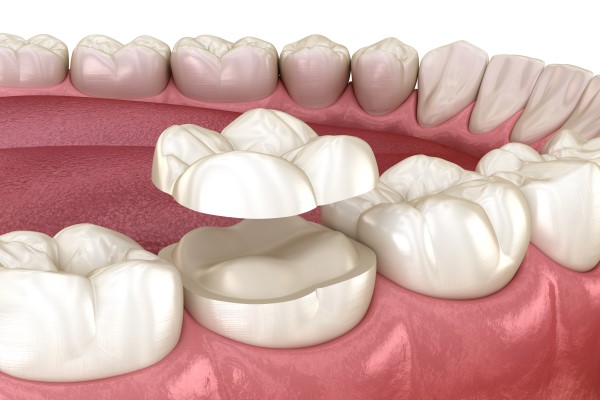When Is a Dental Onlay Better Than a Crown?

A dental onlay is a restoration that is often used to repair damaged or decayed teeth. Onlays offer a strong and long-lasting reparative solution to tooth decay or similar damage. These restorations provide a host of benefits. In some cases, an onlay is considered to be a better alternative to a crown and other types of dental restorations. Read on to find out when your dentist may decide to use a dental onlay instead of a crown.
Dental onlay
An onlay or inlay is used when a cavity is too large for a regular filling. Both onlays and inlays are pre-formed in a laboratory before being bonded to the decayed or damaged tooth. They are a more conservative approach than a dental crown since they do not involve the removal of healthy tooth structure. One important thing that is often considered when deciding which option to use is the amount of tooth structure that has been lost to decay or wear.
An inlay is molded to fit into the grooves that are within the cusps of the teeth. A dental onlay is larger than a dental inlay but smaller than a dental crown. It fits within the grooves but wraps up and over the cusps and covers more of the tooth’s surface. A dental onlay is often used to repair a tooth that has more extensive damage affecting the cusp or potentially the biting surface.
Dental onlay and crown
A dental crown offers several benefits, but it involves the removal of more healthy tooth structure than needed. To avoid removing healthy tooth structure, the dentist may opt to use a dental onlay instead of a crown. Onlays can help to preserve as much healthy tooth as possible. In some cases, crowns can also increase the risk of tooth fracture and the need for a root canal.
Types of onlays
Dental onlays can be made from resin materials, porcelain, or gold. One major difference between them is the appearance of the finished restoration. Porcelain and ceramic onlays are more cosmetically pleasing than gold and can be stained to match the rest of the affected and surrounding teeth. These are often recommended for front teeth.
Moreover, porcelain and ceramic onlays allow dentists to bond the onlay to the tooth, which helps to create an effective seal. Gold or resin are the ideal materials for molars and pre-molars because of their strength and durability. Gold is often considered to be one of the strongest options but is not the most esthetic. A dentist can suggest options that would be suitable depending on a patient’s needs.
A dental onlay may be the right option for you
Your dentist may recommend an onlay when your tooth structure is weak and they suspect that it would end up cracking if filled with a regular filling. Using an onlay may also be ideal because it preserves healthy tooth structure while restoring damaged or decayed areas, which helps ensure functional longevity. To learn more about dental onlays, talk to your dentist. Your dentist can advise if a dental onlay is the right treatment for you.
Request an appointment here: https://smilesonmichigan.com or call Smiles On Michigan at (312) 509-9492 for an appointment in our Chicago office.
Check out what others are saying about our dental services on Yelp: Dental Onlays in Chicago, IL.
Recent Posts
A dentist’s job is to make sure your teeth stay in great health. For many patients, this means considering the benefits of dental restorations. Dentists recommend restorative procedures when a patient has a damaged, diseased, or missing tooth. These standard treatments stop the problem in its tracks, prevent additional injury and infection, and even provide…
Dental restorations have been used for thousands of years. In fact, a 2012 article published by The New York Times details the discovery of a 6,500-year-old human jawbone. Considered the earliest evidence of dental fillings, it had beeswax in one tooth, which researchers believe was to ease the pain of a crack. These days, restorations…
The purpose of dental restorations is to replace permanent teeth that are lost. This can happen because of trauma to the tooth that renders it irreparable or decay that is so extensive that it requires extraction. There are several restoration options for replacing a missing tooth. Some are removable while others are permanently fixed in…
Thanks to advanced dental restorations, tooth loss is not the inevitable outcome of decay or damage that it once was. Restorations — including fillings, crowns, bridges, and implants — are designed to restore or replace damaged tooth structures or to prevent the advancement of decay. Many restorations can also improve the appearance of a patient’s…